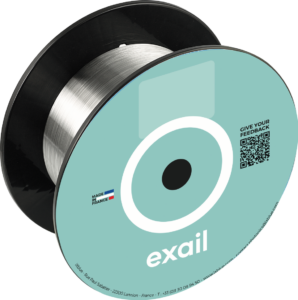- Photonics & Space
Powering multi-photon microscopy with neodymium doped fiber lasers
Laser sources based on neodymium (Nd) doped fiber is an unrivaled technology for fluorescence imaging.
Bio or medical imaging relies on the ability to image, in real-time and with ultimate high-resolution, living biological materials (i.e cellular tissues at depths of about one millimeter), while being totally non-invasive. Laser sources are used in a technique called “two-photon fluorescence excitation microscopy”. It requires ultrafast pulsed lasers capable of producing high peak power with low pulse energy to avoid degradation of living cells. Fiber based lasers are ideal solutions for this application. They are much easier to install and to maintain than solid state lasers.
920 nm is one of the main wavelengths used for this application, the linewidth where scattering loss is reduced and where fluorescent proteins are available. Laser sources based on Nd-doped fiber can be used as femtosecond pulsed lasers in the 920 nm region for “two-photon microscopy”.
For over a decade, Exail has been engaged in a fruitful collaboration with the team of Mathieu Laroche, researcher at the CIMAP lab in Caen (a joint research lab of CNRS/CEA/ENSICAEN/Univ. of Caen-Normandie) aiming to develop new laser sources based on Nd-doped optical fibers for short infrared and blue/deep-UV wavelength laser emission. Exail’s portfolio now counts Nd-doped fibers perfectly adapted to these applications.
The sole industrial reference of Nd-doped fiber dedicated to 920 nm laser sources
Lasers based on ytterbium doped optical fibers are quite common today and efficient in the 1000-1100 nm region. However, among all silica-based fiber lasers, only the one based on Nd-doped optical fibers can efficiently reach shorter wavelengths, in the 900 nm range. The development of Nd-doped fiber lasers is challenging. There is a competition between two transitions of neodymium in the doped core, the transition at 910 nm (3-level scheme) and at 1060 nm (4-level scheme). The latter is much more efficient and must be attenuated to foster the emission at 900 nm. A second major challenge is the non-linear effects appearing, in pulsed regime and single-frequency regime, when the power increases in the optical fiber. The last challenge comes from clustering effect of neodymium ions, leading to ion pairs inducing non-radiative energy transfers highly reducing the fiber efficiency.
The different technological challenges towards the industrialization of the Nd-doped fibers were successfully overcome by Exail, leveraging its manufacturing know-how of specialty fibers developed over the past 10 years. In particular a “W-profile” shaping of the index developed during the collaboration with Mathieu Laroche team was used to obtain a controlled leak for emission above 1 μm. This was a crucial technological step because with the “W-profile” a high gain (up to 25 dB) in the 890-930 nm range can be obtained by suppressing the parasitic emission in the 1000-1100 nm range. The fiber cladding size is reduced to 80 μm to reduce the neodymium concentration (and thus the clustering) while maintaining the pump absorption level. The double clad fiber (“IXF-2CF-Nd-PM-5-80-D1”) has a 5 μm core and a panda polarization maintaining design needed for most applications. This product is highly efficient to amplify low input power, the main limit being the nonlinear effects in single frequency or short-pulse regime.
Exail overcame this limit by extending the core size and using a reduced clad-to-core ratio to favor gain around 920 nm. The fiber core is single mode, and the clad-to-core ratio has been designed to optimize gain of the 3-level transition from 890 nm to 930 nm. A Double Clad neodymium PM fiber with 12 μm core, 80 μm cladding diameter (IXF-2CF-Nd-PM-12-80) is now available for implementation within a MOPA configuration. The first limit of this fiber is the 1060 nm parasitic emission which is dependent on the input power, this technology can amplify signal in the 890-930 nm region to more than 5 W.
To further increase the output power or the pulse energy of 890-930 nm lasers, a very large mode area (VLMA) fiber has been developed with a 30 μ m core and 125 μ m cladding diameter. The clad-to-core ratio of 4 has been carefully selected to optimize the gain in the region of interest and can produce high power of few tens of watt. The fiber core numerical aperture (NA) has been reduced to ensure good beam quality.
The Nd-doped fiber family produced by Exail is the only industrial reference of the market dedicated to applications using 920 nm laser sources. It has been optimized for the 890-930 nm region and 3 different designs have been developed to address a wide power range from a few mW to tens of watt in short pulse or single frequency regime. All the fibers have a polarization maintaining design. Single clad fibers are also offered and would be ideal to build seeder sources. The different fibers can also be delivered integrated with components such as fibered pump combiners perfectly matching Exail fibers.

Towards watt-level deep-UV and blue lasers for quantum technology and other applications
Nd-doped fiber laser sources can emit at high power (more than 80 W) near 900 nm which is useful in many scientific or technological applications requiring accuracy as much as strict power. Another advantage of the Nd-doped fiber laser is the possibility to double or even quadruple its frequency via non-linear crystals, to obtain several watts of power in the blue region (450 nm) or around a watt in even shorter wavelengths (in deep-UV around 225 nm).
As a source of continuous-wave single-frequency in the blue domain (frequency doubled), they can be used to cooldown strontium atoms for quantum applications. But Nd-doped laser sources can also serve as lasers emitting in the deep-UV to fasten the material processing/characterization (due to their high energy and accuracy), to replace excimer lasers (i.e Fiber Bragg Gratings inscription) or to generate laser induced fluorescence to detect explosive devices (at around 230 nm).


